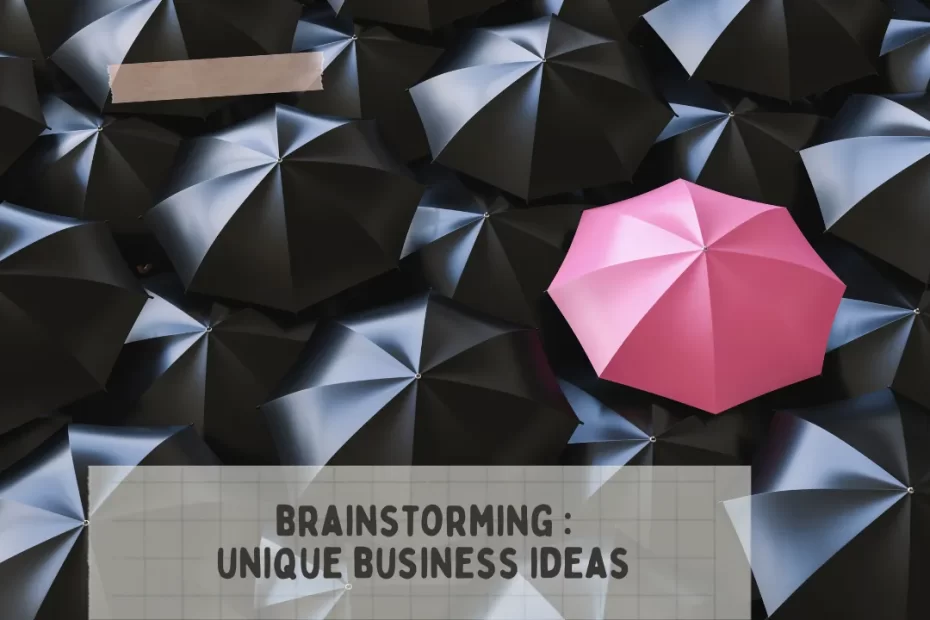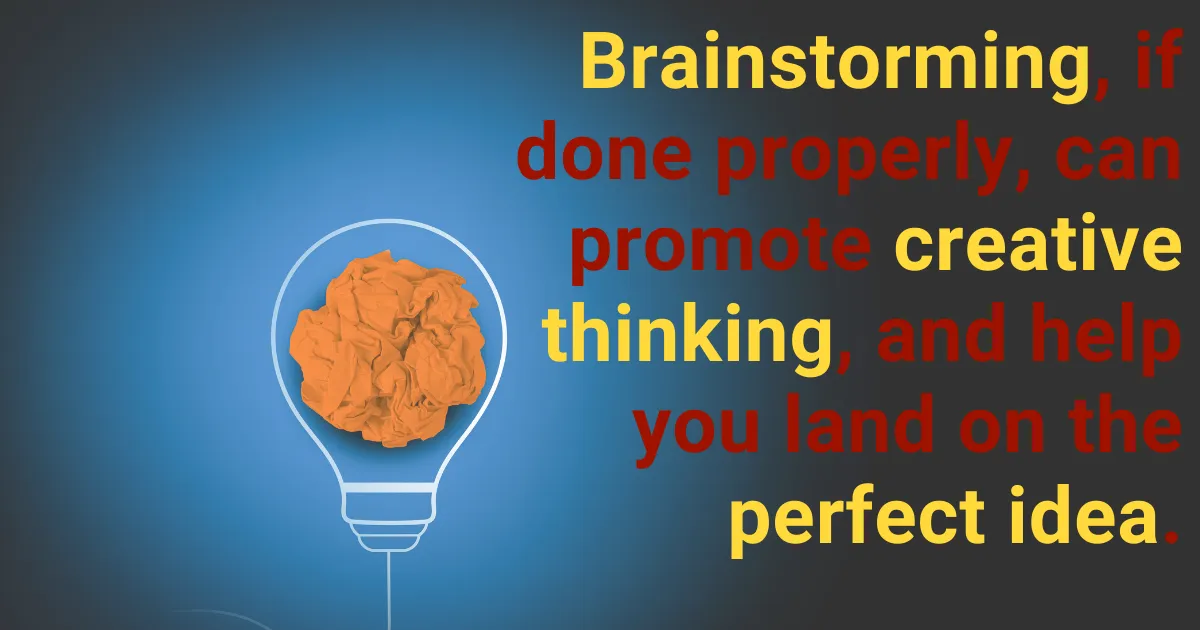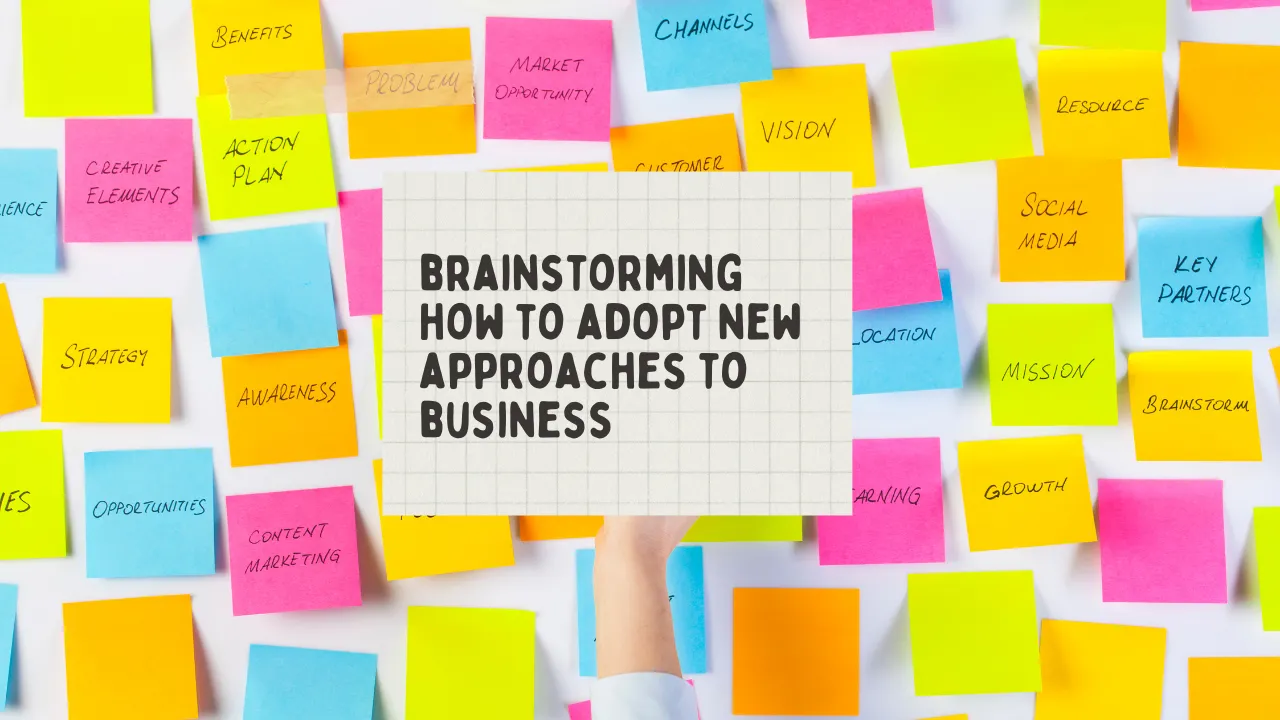Brainstorming (business ideas) is a powerful technique that can stimulate creative thinking and lead to discovering the perfect idea. It is a powerful tool that can unlock the doors to creativity and help you find that perfect idea.
Whether working on a project, planning an event, or looking for new business strategies, brainstorming allows you to explore different perspectives, generate new ideas, and make connections you might not have considered.
Brainstorming Technique
Here’s how it works:
Freethinking: Brainstorming encourages participants to think freely and generate various ideas without judgment or criticism. This opens up the possibility for innovative and unconventional thinking.
Diverse Perspectives: When individuals with different backgrounds, expertise, and perspectives come together to brainstorm, it brings a wealth of ideas. This diversity stimulates creativity and provides unique insights and solutions.
Collaboration: Brainstorming promotes cooperation and teamwork. By bouncing ideas off one another and building on each other’s suggestions, the group’s collective intelligence can be harnessed to create something greater than the sum of its parts.
Idea Generation Techniques: Various techniques can be employed during brainstorming sessions to fuel creative thinking. These can include mind mapping, word association, role-playing, or even using random prompts. Such techniques help break free from conventional thought patterns and spark new ideas.
Nonlinear Thinking: Brainstorming encourages nonlinear thinking, allowing participants to make connections between seemingly unrelated concepts or ideas. This can lead to innovative and out-of-the-box solutions that may not have been considered otherwise.
Iteration and Refinement: Brainstorming is often an iterative process. Initial ideas may be refined, combined, or expanded upon to develop the perfect idea: the group’s collective feedback and input help shape and improve the concepts.
Remember, during brainstorming, it’s essential to create a safe and nonjudgmental environment where all ideas are welcomed. Encourage participants to think freely and contribute without fear of criticism. By leveraging the power of brainstorming, you can tap into your team’s creative potential and uncover that perfect idea.
Create A Safe And Open Environment For Brainstorming With Your Team
Creating a safe and open environment for brainstorming with your team is crucial to encourage participation and foster creativity. Here are some tips to help you create that atmosphere:
Establish a judgment-free zone: Emphasize that during brainstorming sessions, all ideas are welcome and no criticism or judgment should be made. Encourage team members to freely express their thoughts without fear of ridicule or rejection.
Lead by example: As the facilitator, demonstrate openness and respect for all ideas. Encourage active listening and show appreciation for each team member’s contribution. This sets the tone for a safe and inclusive atmosphere.
Set clear guidelines: Establish guidelines at the beginning of the session to ensure everyone understands the purpose and rules of the brainstorming process. Encourage equal participation, active engagement, and the generation of diverse ideas.
Encourage collaboration: Foster a sense of collaboration by encouraging team members to build upon and expand upon each other’s ideas. Create an environment where everyone feels comfortable building upon existing ideas or suggesting variations.
Use icebreaker activities: Start the session with icebreaker activities to help team members feel more comfortable and connected. This can include fun and light-hearted activities that encourage interaction and set a positive tone for the brainstorming session.
Provide anonymity options: If some team members may feel hesitant to share their ideas openly, consider providing anonymous brainstorming options. This can be done through anonymous suggestion boxes or using online collaboration tools that allow for anonymous contributions.
Foster a growth mindset: Encourage a growth mindset within the team, emphasizing that brainstorming is a process of exploration and iteration. Emphasize that failure is a natural part of the creative process and that all ideas, regardless of their outcome, contribute to the overall progress.
Remember, creating a safe and open environment for brainstorming requires ongoing effort and reinforcement. By implementing these strategies, you can help your team feel comfortable expressing their ideas, leading to more fruitful and creative brainstorming sessions.
Effective Brainstorming Techniques & Benefits To Generate Creative Ideas
Quantity over Quality: During brainstorming, the focus is on generating a large number of ideas rather than immediately evaluating their quality. By encouraging a high volume of ideas, you increase the chances of discovering unique and innovative solutions.
Breaking Barriers: Brainstorming helps break down mental barriers and inhibitions that can hinder creativity. It creates a safe space where participants feel comfortable sharing even their wildest or seemingly impractical ideas, which can often serve as catalysts for breakthrough thinking.
Stimulating Creativity: By engaging in brainstorming, individuals are encouraged to think outside their usual patterns of thought. This stimulates creativity by challenging assumptions, exploring new perspectives, and fostering a mindset of exploration and curiosity.
Enhancing Team Dynamics: Brainstorming sessions can enhance team dynamics by promoting collaboration, communication, and trust among team members. It provides an opportunity for individuals to contribute their unique strengths and expertise, fostering a sense of shared ownership and collective problem-solving.
Synergy of Ideas: Through the collaborative nature of brainstorming, different ideas can intersect and combine, leading to the emergence of even stronger and more innovative concepts. This synergy can result in solutions that surpass what any individual could have come up with on their own.
Uncovering Hidden Gems: Sometimes, the most valuable ideas or insights may emerge unexpectedly during a brainstorming session. By creating an open and supportive environment, participants can feel empowered to share their perspectives, leading to the discovery of hidden gems that may have otherwise gone unnoticed.
Flexibility and Adaptability: Brainstorming encourages flexibility and adaptability in problem-solving. It allows for quick iterations, adjustments, and refinements of ideas based on feedback and evolving insights. This agility can be crucial in finding the most effective and efficient solutions.
Remember, effective brainstorming requires active facilitation, clear objectives, and a structured approach. Providing guidelines, time for individual ideation, and fostering a positive and inclusive atmosphere is essential for harnessing the full potential of brainstorming sessions.
Overall, brainstorming is a valuable tool for promoting creative thinking, encouraging collaboration, and ultimately helping you land on the perfect idea or solution to a problem.
How Can Businesses Brainstorm Innovative Approaches Effectively?
1. Foster a Creative Environment
- Encourage Open Dialogue: Create a culture where team members feel comfortable sharing their ideas without fear of judgment. This openness can spark creative solutions and new approaches.
- Diverse Perspectives: Bring together people from different backgrounds and departments. Diverse perspectives can lead to unique insights and innovative ideas.
- Inspire Creativity: Use stimulating environments, such as creative workshops or brainstorming sessions, to help employees think outside the box. Physical spaces that are conducive to creativity can also enhance idea generation.
2. Use Structured Brainstorming Techniques
- Mind Mapping: Use mind mapping tools to organize thoughts and ideas visually. This can help connect various concepts and uncover new approaches.
- SCAMPER Method: Apply the SCAMPER technique—Substitute, Combine, Adapt, Modify, Put to another use, Eliminate, and Reverse—to existing products or processes to generate innovative ideas.
- Six Thinking Hats: Adopt Edward de Bono’s Six Thinking Hats method to explore ideas from multiple perspectives—emotional, logical, critical, creative, etc.
3. Leverage Data and Trends
- Market Research: Analyze market trends, customer feedback, and competitive landscape to identify gaps and opportunities. This data can guide brainstorming sessions towards more relevant and impactful ideas.
- Trend Analysis: Monitor industry trends and emerging technologies. Understanding these can help you brainstorm ideas that align with future market needs.
4. Implement Ideation Tools and Techniques
- Idea Management Software: Utilize digital tools and platforms that facilitate idea collection and evaluation. These tools can help organize and prioritize ideas more effectively.
- Innovation Workshops: Conduct regular workshops focusing on innovation. These workshops can provide structured sessions for idea generation and problem-solving.
5. Encourage Experimentation and Risk-Taking
- Pilot Testing: This method involves testing new ideas on a small scale before a full rollout. It allows businesses to refine ideas based on real-world feedback and reduce risks.
- Fail Fast Philosophy: Embrace a culture that views failures as learning opportunities. This mindset encourages experimentation and innovation by reducing the fear of failure.
6. Involve External Perspectives
- Consult with Experts: Engage industry experts or consultants who can offer fresh insights and innovative ideas outside the organization.
- Customer Feedback: Actively seek and incorporate customer feedback to better understand their needs and preferences. This can guide the brainstorming process towards more customer-centric solutions.
Conclusion: Effective brainstorming of innovative approaches requires fostering a creative environment, using structured techniques, leveraging data, implementing ideation tools, encouraging experimentation, and involving external perspectives. By integrating these strategies, businesses can enhance their ability to generate and adopt new ideas, leading to more effective and innovative solutions.
Recommendations:
- Regularly schedule brainstorming sessions and innovation workshops.
- Utilize ideation tools to capture and refine ideas systematically.
- Continuously monitor industry trends and customer feedback to guide the brainstorming process.
How to Evaluate the Success of New Business Approaches
Evaluating the success of new business approaches involves several key steps:
Define Clear Objectives: Establish specific, measurable goals for the new approach. These could include increased revenue, market share growth, or improved customer satisfaction.
Track Key Performance Indicators (KPIs): Identify and monitor KPIs relevant to the objectives. For instance, if the goal is revenue growth, track metrics such as sales figures, conversion rates, and customer acquisition costs.
Gather and Analyze Data: Collect data from various sources, including sales reports, customer feedback, and market analysis. Use this data to assess whether the new approach meets the predefined objectives.
Conduct Comparative Analysis: Compare the new approach’s performance against past methods or industry benchmarks. This helps you understand the innovation’s relative success and impact.
Seek Stakeholder Feedback: Obtain feedback from employees, customers, and other stakeholders involved or affected by the new approach. Their insights can provide valuable perspectives on its effectiveness.
Review Financial Impact: Assess the financial performance of the new approach by analyzing cost-effectiveness, return on investment (ROI), and profitability.
Adapt and Improve: Based on the evaluation, make necessary adjustments to refine the approach and address any identified issues for continued improvement.
By following these steps, businesses can systematically evaluate the success of new approaches and ensure they are contributing effectively to organizational goals.
Share this:
- Click to share on Facebook (Opens in new window) Facebook
- Click to share on Pinterest (Opens in new window) Pinterest
- Click to share on LinkedIn (Opens in new window) LinkedIn
- Click to share on X (Opens in new window) X
- Click to share on Tumblr (Opens in new window) Tumblr
- Click to share on Bluesky (Opens in new window) Bluesky









For my thesis, I consulted a lot of information, read your article made me feel a lot, benefited me a lot from it, thank you for your help. Thanks!
Create a safe space for ideas. Encourage your team to think freely and without judgment. Remember, there are no bad ideas in brainstorming! Every idea can lead to a breakthrough.
Embracing new approaches to business is crucial for staying ahead in today’s dynamic market. This post really highlights the importance of adaptability and innovation. Thanks for sharing these valuable insights!
The business landscape is constantly changing, and it’s essential to be open to new approaches. This post does a fantastic job of encouraging businesses to be proactive and adaptable. Thanks for sparking this important conversation!
The competition is fierce, no doubt. But AI also offers tools creators can leverage. Think about using AI for research, editing, or even generating initial drafts. The key is to use AI to enhance your creativity, not replace it. And syndication can still be valuable for reaching new audiences, just be selective